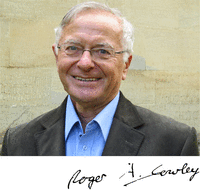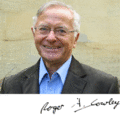Roger Cowley facts for kids
Quick facts for kids
Roger Cowley
|
|
|---|---|
 |
|
| Born |
Roger Arthur Cowley
24 February 1939 |
| Died | 27 January 2015 (aged 75) |
| Alma mater | University of Cambridge (BA, PhD) |
| Awards |
|
| Scientific career | |
| Institutions | University of Oxford University of Edinburgh |
| Thesis | The lattice dynamics of ionic crystals (1964) |
Roger Arthur Cowley (born February 24, 1939 – died January 27, 2015) was an English physicist. He was an expert in studying how tiny particles move and behave inside solid materials. He was also a member of important science groups like the Royal Society.
Contents
Early Life and Education
Roger Cowley was born in Woodford Green, Essex, England, on February 24, 1939. His father, Cecil Arthur Cowley, worked as a surveyor. His mother, Mildred Sarah Nash, came from a farming family.
During World War II, his family moved to Leighton Buzzard. Later, they moved to Shenfield and then to Gidea Park, Essex. Roger went to Brentwood School after winning a scholarship.
After school, he went to Trinity Hall, Cambridge, a college at the University of Cambridge. There, he studied natural sciences. He continued his studies at Cambridge to earn his PhD degree.
On April 4, 1964, Roger Cowley married Sheila Joyce Wells, who was a mathematics teacher. They had two children together. Roger Cowley passed away on January 27, 2015, in Oxford.
Roger Cowley's Scientific Career
Roger Cowley became a professor of physics at the University of Edinburgh in 1970. Later, in 1988, he became a special professor at the University of Oxford. This job also meant he was a fellow at Wadham College, Oxford.
He became well-known for his work in neutron scattering. This is a way scientists use tiny particles called neutrons to study the structure of materials. His research helped us understand how materials change from one state to another, like ice melting into water. These changes are called phase transitions.
Awards and Recognition
Roger Cowley received many important awards for his scientific work. In 1972, he was chosen as a fellow of the Royal Society of Edinburgh. The next year, he won the very first Max Born Prize.
In 1978, he became a Fellow of the Royal Society (FRS). This is a big honor for scientists in the UK. He also received the Fernand Holweck Medal and Prize in 1990. In 2003, he won the Walter Hälg Prize. In 2008, he was given the Faraday Medal and Prize from the Institute of Physics.
Images for kids


